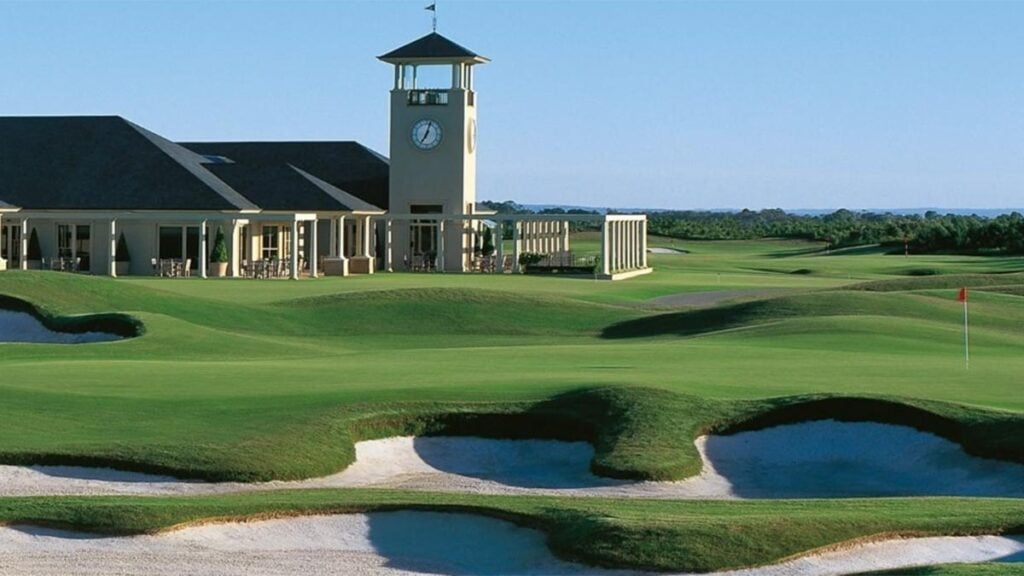My inside-the-ropes view of McIlroy making history at the Masters.
Reporting from inside the ropes at the Masters is the greatest professional privilege in televised golf. CBS began the practice only this decade. Even as a professional on the LPGA Tour for 17 years – I played on six US Solheim Cup teams and won 17 tournaments, including the Dinah Shore twice – the things I see at the Masters astonish me, and none of the 10 Masters I’ve worked as a CBS announcer quite compares to the one we saw this year. The 2025 Sunday match-up of Rory McIlroy vs Bryson DeChambeau, the great supporting cast who had chances until late and all the chaotic ups and downs made it the most thrilling Masters I’ve been to. A friend irreverently referred to it as “bipolar golf”, while I called it the “Rorycoaster”. Neither of us were wrong.
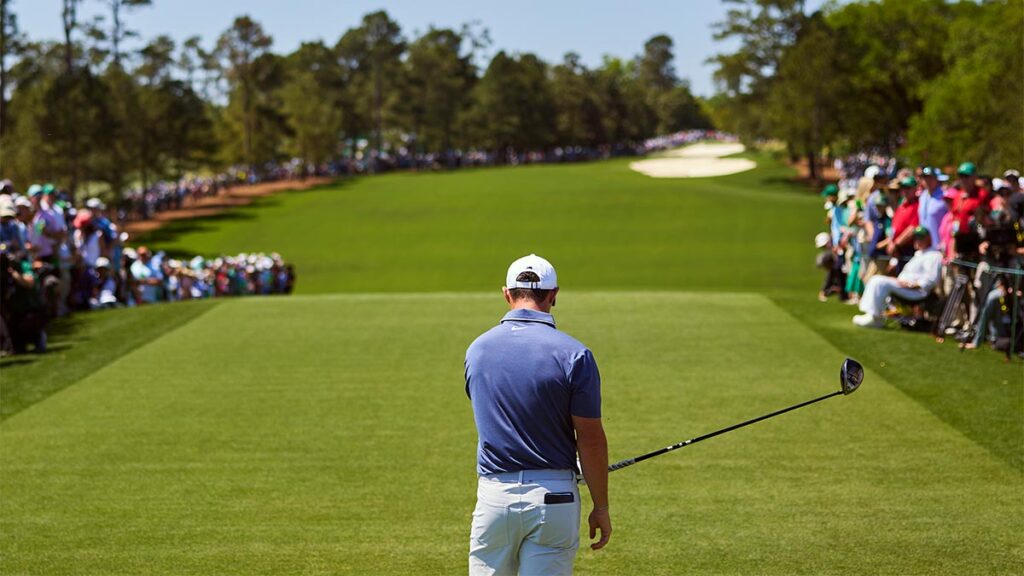
On Sunday at the Masters, first impressions matter. When Rory and Bryson arrived at the first tee, their countenances were very different. Bryson made a gladiator entrance, exuberant. He was trying to create an atmosphere he could feed off. Rory was tighter, more serious, a little edgy. On the first hole on Saturday, McIlroy carried his tee shot 343 yards and cleared the fairway bunker by a good 15 paces. On Sunday, he failed to clear the bunker by a yard, a clubhead speed difference of maybe four miles per hour. You could sense his concern and determination to find his game.
How do Rory and Bryson differ as golfers? Rory hits it high and naturally right to left, while Bryson will occassionally surprise with a low, penetrating bullet. Both hit it forever, but I think Rory has an extra gear of power that neither Bryson nor anyone else has. Rory is a more organic golfer, more artistic in his approach. He’s also more emotional in the sense that what he feels in his heart he transfers to the club. He flights the ball more impressively and in creative ways that again, I think, come directly from his soul. This emotional quality can sometimes cut both ways. After all, he had to win this Masters while making four double-bogeys. I’m not diminishing Bryson at all. When Bryson is on-point and executing, he’s capable of anything and is completely unafraid, but on balance, I’d give the nod to Rory.
After two holes, Rory had gone from two strokes ahead to one behind. At the par-4 third, I saw a quality in him I’d never seen before: anger – not frustration or fear, just downright anger and defiance. It’s not his normal way. On the third hole his plan was to lay up for position. That strategy went out the window. He smoked his drive to an ideal position just shy of the green, then, with the same angry air, hit a lovely little pitch and made a birdie to Bryson’s bogey. Then came Rory’s beautiful tee shot at the fourth and another birdie to Bryson’s bogey. Of course, so much craziness would transpire, but to me the tournament flipped at the fourth hole.
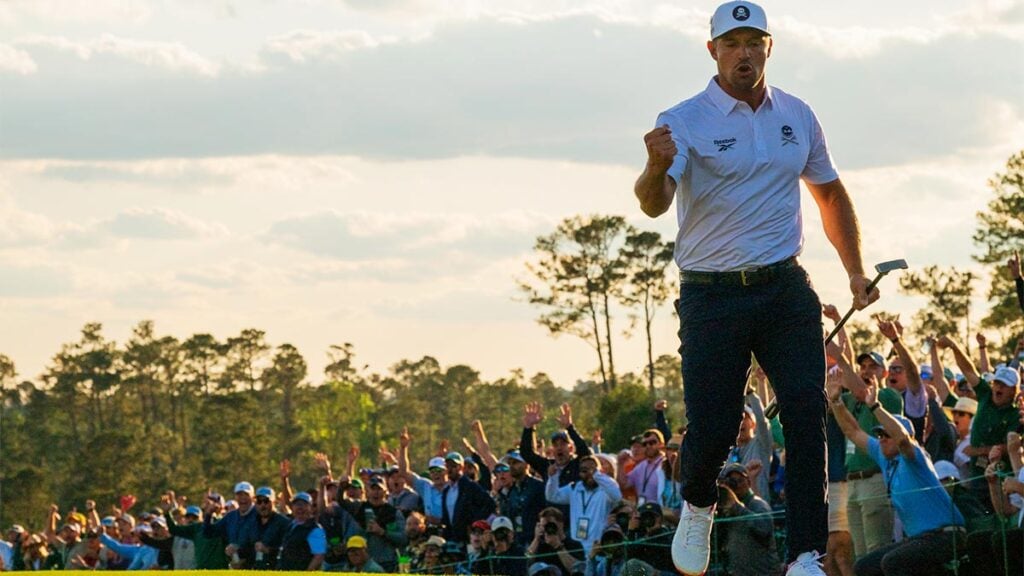
Rory is human and imperfect, which is one reason I think the patrons fell in love with him all over again. He has the best laugh in golf – though Scottie Scheffler’s is close – and has a mischievous Irish twinkle in his eye. He likes to needle a little and can take it, too. There’s a kindness and openness about him that appeals to the average Joes and Janes out there.
An arresting thing about Rory is that he’s not very tall – just 5-foot-9. His hands aren’t large, and he doesn’t have Popeye forearms, but he’s deceptively thick around the shoulders. When you give him a friendly pat on the back, it’s like hitting rock, and his core is like iron. Then there’s his flexibility, quickness and flash speed, which you can’t teach and are off the charts.
Augusta National rewards power, no doubt about that, but it’s still largely about finesse. Distance control with short irons and wedges around the green are still enormously important. The golfer with the advantage is the one who chooses “high lines”. That means playing more break on putts than usual and allowing longer iron shots to follow green contours more generously. Rory aims drives on the high side of the fairways and “paints” the ball around that course. When guys attack Augusta in a more head-on fashion, they’ll start to bleed strokes, and disasters can happen.
The cheering interests were fascinating to observe, especially the way they shifted. Bryson had the “bro” crowd with him, louder and brash with a lot of chirping. Rory seemed to appeal more to traditionalists. By the ninth hole, after Rory had gotten on track and Bryson wasn’t responding, the bro crowd became more subdued. Bryson wasn’t out of it by any means, but the sentiment had shifted permanently in Rory’s favour. The most telling moment came after Rory hit that great tee shot to the 16th green. The roar was tremendous, but then the scoreboard suddenly registered Justin Rose’s birdie on 18 to get to 11-under to tie him with Rory. The patrons groaned. It wasn’t a boo – Rose is popular and respected – but a dismaying sound that suggested this Masters may be slipping from Rory’s grasp. The patrons wanted Rory to win.
Rory did something on the 17th hole that only great players do. As he prepared to hit his approach, a whisper of wind came up. It was very slight, barely perceptible. Rory, even with his adrenaline flowing, noticed it, stepped away and waited for the air to settle. That second shot requires tremendous precision, and most players amid the excitement would be oblivious to something so small. His poise there showed one of many reasons he’s a generational player.
It wasn’t all about Rory, Bryson and Justin Rose, of course. Don’t forget, Ludvig Aberg was on the periphery until the last two holes. I’m huge on that young man and predict he’ll win multiple majors before he’s done. After he finished with a triple-bogey 7 on the final hole, it occurred to me that the disaster cost him something like $500,000. I also thought about something Lee Trevino said years ago. “Forget about it and keep going,” he said. “It was never your money to begin with.”
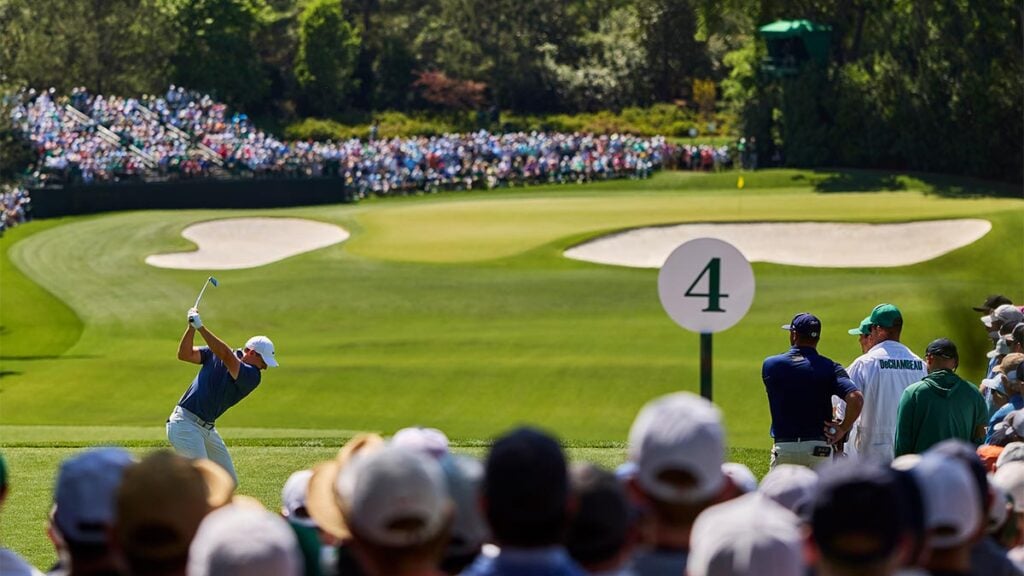
How do we announcers know which clubs the players are hitting? I have an assistant, Wayne Richardson, who has been my spotter for 10 years, and he helps catch the signals from the caddies – in this case, Harry Diamond for Rory, Greg Bodine for Bryson. It’s all with one hand. If a 5-iron or longer, they flash that number of fingers, pointing up. If it’s shorter than a 5-iron, they will flash the fingers, pointing down, off a base of five, so a 6-iron is one finger pointed down. A pitching wedge is a fist. A gap wedge is touching the bill of the cap with two fingers. For an ordinary sand wedge, they trace the letter S in the sky with their finger. For a lob wedge, they make an L, like the “loser” sign.
The loudest Sunday roar came at an unlikely place. Usually, the biggest roar occurs on No.16 because of the way sound reverberates though the corridor there, but the roar that followed Rory’s amazing second-shot approach to the 15th is the loudest I’ve ever heard in my life. It travelled from the green up the hill and hit me like a truck. Only at Augusta do roars like this happen.
The loudness of the roar was due partly to the loss of trees in that area from Hurricane Helene. Trees dampen noise, and now there are fewer of them. There was nothing divine about that hurricane, but I think it had some unexpected results. It’s changed how much shadows are cast. Certainly, it can affect the way wind circulates. From the drive zone on No.5, you now can see across the par-3 sixth hole, No.16 and up the hill on No.15. With the azaleas blooming, it’s just a bath of colour and more beautiful than ever, the rolling land similar to the way Bobby Jones first saw it in 1930.
Even announcers can choke, or struggle to describe what they’ve just witnessed. When Rory hit his third shot at the par-5 13th into a tributary of Rae’s Creek, I was speechless for a moment. He’d played the hole brilliantly, 3-wood off the tee and then a 7-iron lay-up to his pet distance of roughly 80 yards. I had my eyes trained on a window I expected the ball to be projected into. I know Rory’s launch angles well. But then the ball didn’t appear. Instead, it fluttered and then tumbled into the water. At that moment I had one job: explain what just happened. Even with my 50 years of experience as a player and 22 more as an analyst, I didn’t know what the heck happened. There was some deceleration, for sure, but what else? An imperceptible mini-shank, maybe? A horrible push? A weak mis-hit off the toe? A complete breakdown of timing and rhythm? It didn’t come to me, and I don’t think it came to my colleague Ian Baker-Finch either, and he also had a good view from the tower at No.13. After some hesitation I said, simply, “That’s inexplicable.” I can live with that line because even after watching the re-run umpteen times, I’m still not sure what caused it.
On No.14 Rory’s tee shot over-cut to the right into pinestraw. I got there and saw a window – a low one. It was obvious he was going to punch it low because the terrain will feed the ball towards the green. Instead he hit it high, a towering shot that stopped just short of the green, with a huge mound between him and the hole. It was a truly great, near-impossible shot, and had it clipped a tree, it could have been game over right then. As it was, he made bogey but survived it.
It sure was a chaotic and bizarre
15 minutes.
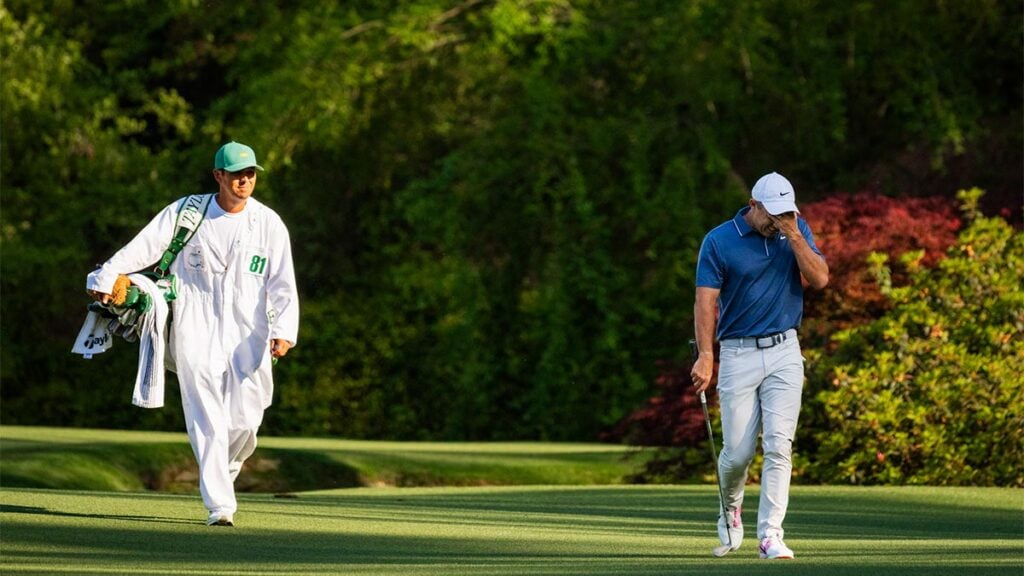
I won’t lie – physically this Masters was a workout. I don’t wear a fitness tracker, but between following groups in early coverage and the afternoons, I suppose it comes to about nine miles of walking daily. It demands that I be in good shape because announcers sounding winded on-air is bad television. I pedal about four miles on the exercise bike at our rental home before I leave for the course, so I’m warmed up when I get there – not bad for a woman who had a partial right-knee replacement in December. I’m in decent shape and don’t regard the physical aspect as a strain. As for the obvious question about visiting the restroom, I don’t. It’s called water management.
I carry just enough water to replace most of what I feel I’m losing. On a typical 70-degree [Fahrenheit] afternoon, that’s about 24 ounces, and not one drop more. The mental part is another story. Every shot is so dear. My concentration is intense because I don’t want to miss a word of what’s coming through my headset, and the words never stop. You ask if I had any interaction with the patrons, and I’m afraid the answer is almost none.
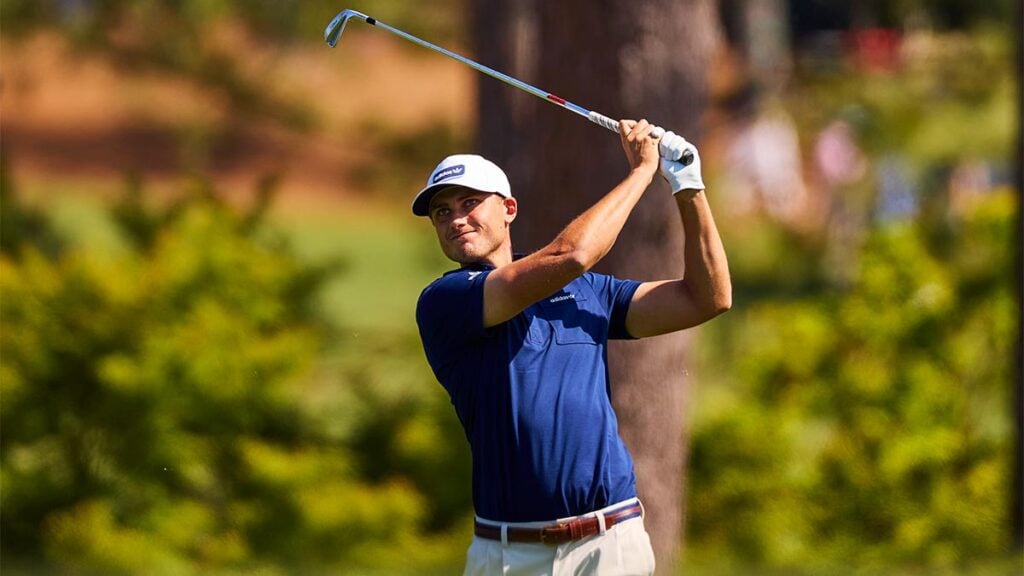
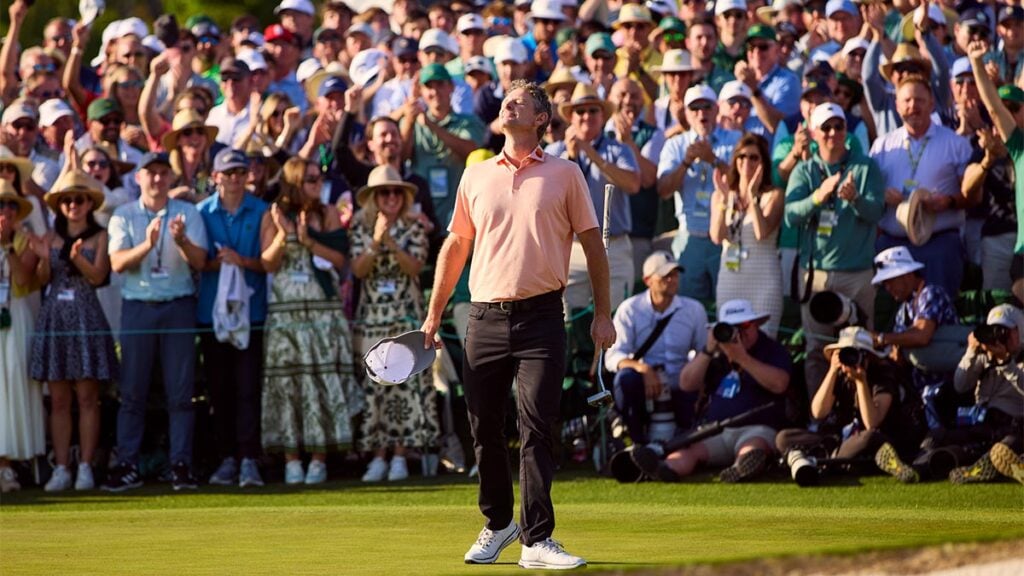
With that, one of the cool things about the walks is seeing patrons who return year after year. One person in particular stands out to me. She’s a blonde woman, roughly my age, always wearing sunglasses and a broad-brimmed hat who sits in a chair behind the 16th tee. Although I’m sure she’s there with friends, she’s always by herself when I pass through. People like her, who I’ve never met personally, and probably never will, strangely have become something like family to me, distant cousins you never get to know but are familiar and strike you as fine people.
I did have an interaction with Rory, though. On Saturday at the par-4 seventh, he drove it into the trees on the right. When I got there, I saw a small opening, and, sure enough, he pulled off a semi-miracle shot that led to a par. He saw me and smiled. On Sunday, he missed big again on No.7, this time to the left. Again, I saw a tiny opening – much smaller than the one on Saturday – and this time he hit it close. It was beyond gutsy, and he caught me shaking my head out of the corner of his eye. I guess my facial expression struck him as hilarious because that was the moment when TV viewers saw him laugh uproariously.
When I was with NBC, Roger Maltbie warned me to never suggest Tiger Woods was dead when he hit it into trouble. “Don’t do it because more often than not he will hit a recovery that will make you look like a damned fool,” Maltbie said. Today I apply that same advice to Rory. It’s a combination of strength, outrageous clubhead speed, an ability to create a swing and sheer determination. Tiger and Rory stand alone as trouble-shot maestros.
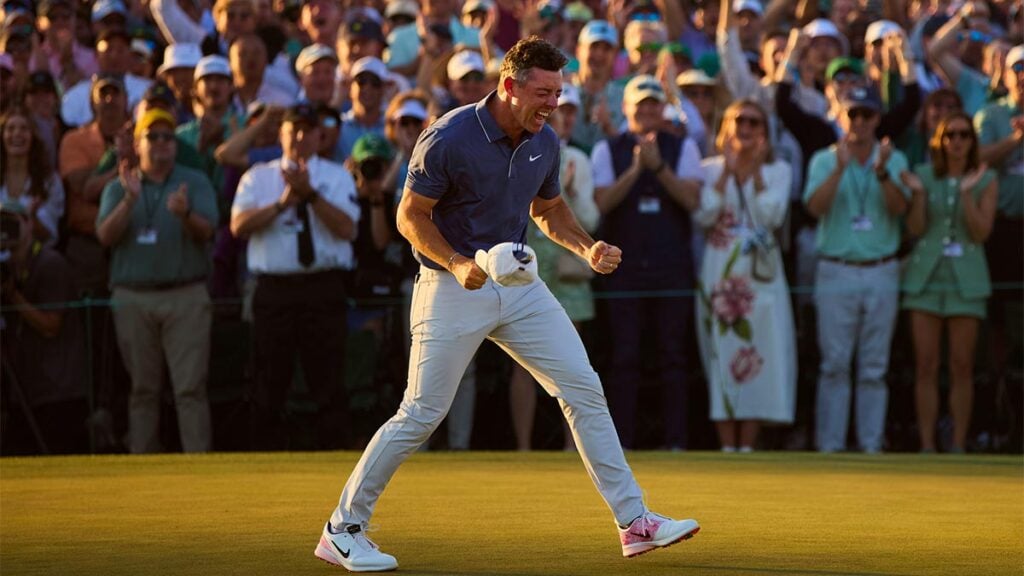
In the aftermath of rory’s victory, I was standing in the walkway behind the 18th green. When Rory exited, he hugged several people with great emotion. When he got to me, I briefly felt a temptation to hug him, too, because we know and like each other, and I appreciated his struggle to complete the career Grand Slam. But I only offered my hand for him to shake, which he did. No hugging, not in that moment and not in my capacity. Within an hour my phone lit up with texts from colleagues and professionals all over the industry. The messages essentially were the same: “I’m so glad you didn’t hug. What a pro you are.” My instincts turned out to be good. This was the Masters, after all.
The variety of flowers and green plants at Augusta National are, of course, something else. Gardening is my great love, and in 2024 the club allowed us access to the greenhouses and potting buildings that are to the left of the 11th hole for a piece on CBS. These places are breathtaking. Inside are all manner of flowers and green plants. One source of amazement was the “back-up azaleas” to ensure we see healthy examples during the tournament. The number of people who caretake these plants is remarkable, and the woman who manages what Augusta National titles their “Plant Health Care Operation”, Abigail Gleixner, is a genius and one of the people I admire most outside golf.
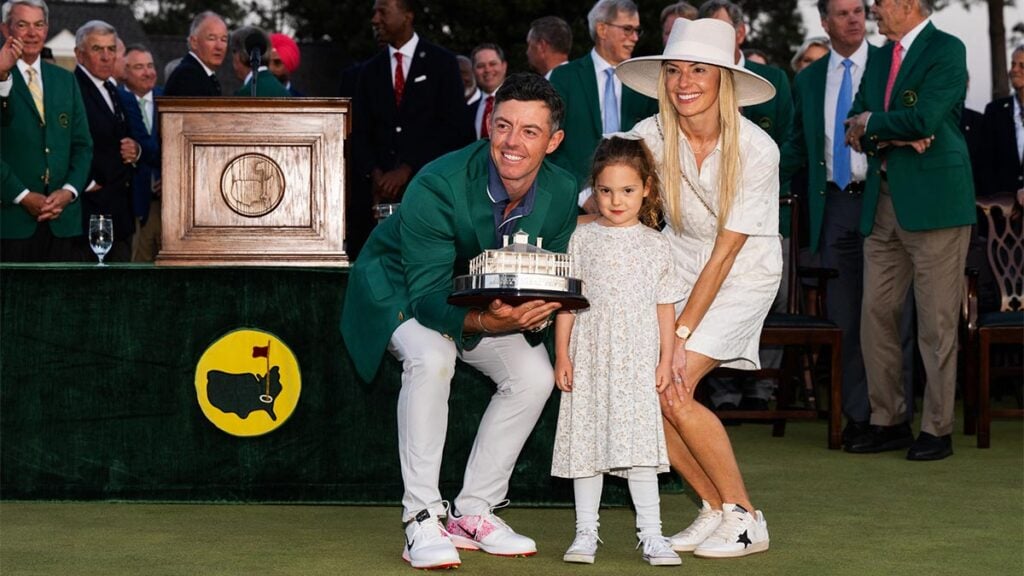
Rory with wife, Erica, and their daughter, Poppy.
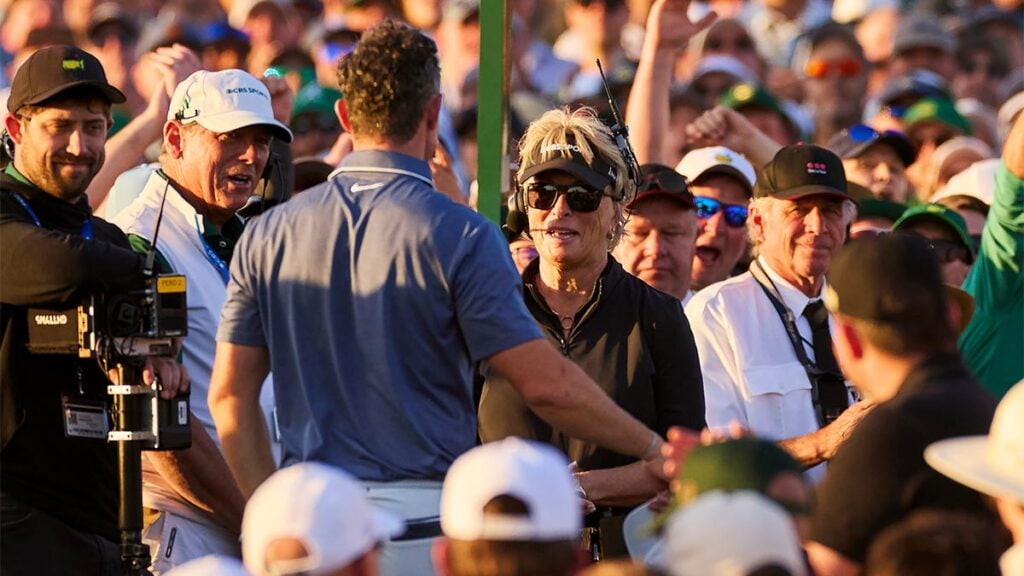
Naturally, I purchased a couple of souvenirs from the merchandise shop. I always get the same thing: six coffee mugs for a group of my favourite gal pals back home. They invade our backyard during tournament week with the mugs, and they frequently fill them with something other than coffee. Last year, one of our besties, a woman I have known since middle school, passed away, so this year, I got only two mugs, one for me and one for my bestie’s husband. Our group gathered at her gravesite just prior to the first round with the mugs. Loyal friends are so important.
On Sunday evening, my housemates, Jeff Sluman and Billy Kratzert, had left town. I was in the house by myself and made something to eat. As I sat over my Bolognese and halibut, I unexpectedly broke into a short cry. It was a happy cry, I suppose, kind of a release after being “on” for a long period of time doing my best for an event that means so much to so many people, me included. Come next April, I hope to cry again.
Photographs by Stephen Denton & J.D. Cuban

